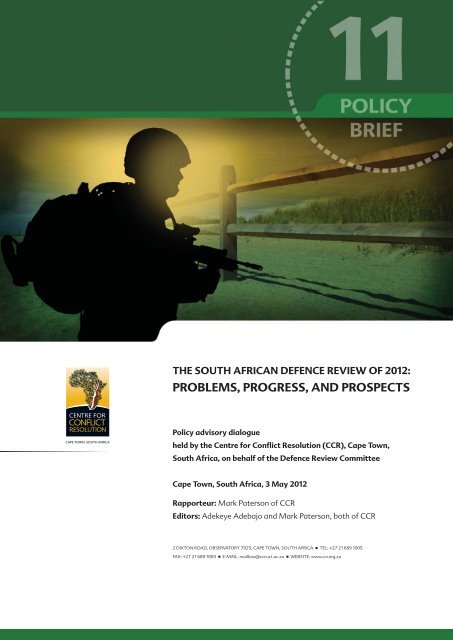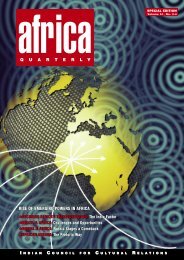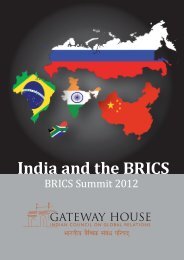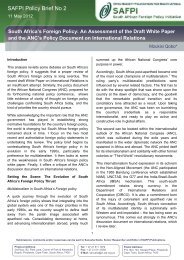Create successful ePaper yourself
Turn your PDF publications into a flip-book with our unique Google optimized e-Paper software.
THE SOUTH AFRICAN DEFENCE REVIEW OF 2012:<br />
PROBLEMS, PROGRESS, AND PROSPECTS<br />
CENTRE FOR<br />
CONFLICT<br />
RESOLUTION<br />
CAPE TOWN, SOUTH AFRICA<br />
<strong>Policy</strong> advisory dialogue<br />
held by the Centre for Conflict Resolution (<strong>CCR</strong>), Cape Town,<br />
South Africa, on behalf of the Defence Review Committee<br />
Cape Town, South Africa, 3 May 2012<br />
Rapporteur: Mark Paterson of <strong>CCR</strong><br />
Editors: Adekeye Adebajo and Mark Paterson, both of <strong>CCR</strong><br />
2 DIXTON ROAD, OBSERVATORY 7925, CAPE TOWN, SOUTH AFRICA TEL: +27 21 689 1005<br />
FAX: +27 21 689 1003 E-MAIL: mailbox@ccr.uct.ac.za WEBSITE: www.ccr.org.za
11<br />
POLICY<br />
BRIEF<br />
THE SOUTH AFRICAN DEFENCE REVIEW OF 2012: PROBLEMS, PROGRESS, AND PROSPECTS<br />
Introduction<br />
In July 2011, an independent committee was appointed by the South<br />
African Minister of Defence, Lindiwe Sisulu, to undertake a review<br />
and update of national defence policy in compliance with the<br />
requirements of a Defence White Paper issued in 1996.<br />
The Defence Review Committee issued a 423-page draft report in April 2012,<br />
and scheduled a series of public imbizos and meetings with interested<br />
parties and experts across South Africa to consult and seek public consensus<br />
on this first review of national defence policy since 1998. About 75 academics,<br />
civil society leaders, military experts, and diplomats were convened by the<br />
Centre for Conflict Resolution (<strong>CCR</strong>) in Cape Town, South Africa, to discuss<br />
the document, which was described as a “constitution for the defence force’s<br />
future” by the committee’s chair, former South African Minister of Defence<br />
(1991-1992), Roelf Meyer. After the nation-wide consultation, a revised draft of<br />
the report was scheduled to be submitted to Parliament for approval in<br />
August 2012.<br />
‘<br />
The draft South<br />
African Defence<br />
Review 2012 aims to<br />
support goals set by<br />
the national government<br />
and proposes a<br />
“fundamental shift”<br />
from the priorities of<br />
the previous<br />
’<br />
review<br />
in 1998<br />
The draft South African Defence Review 2012 aims to support goals set by<br />
the national government and proposes a “fundamental shift” from the<br />
priorities of the previous review in 1998, which focused on the integration of<br />
forces from the former South African army and the African National<br />
Congress’s (ANC) Umkhonto we Sizwe (MK) after democratic rule was<br />
established in 1994; and the normalisation of security relations in Southern<br />
Africa following the wars and destabilisation efforts of the apartheid regime<br />
against the frontline states which resulted in an estimated one million deaths<br />
and $60 billion in damage in the 1980s.<br />
The document describes “growing” regional and domestic responsibilities<br />
that need to be shouldered by South Africa’s military. In addition to<br />
addressing core concerns about protecting national interests and ensuring<br />
proper accountability of the armed forces to government, the 2012 review<br />
also highlights the military’s regional role in peacekeeping missions in Africa;<br />
Tshwane’s broader foreign policy response to the African “strategic<br />
environment”; the role of the armed forces in the policing of national borders<br />
and the provision of support to civil authorities in times of crisis; and the role<br />
that the South African National Defence Force (SANDF) can play in<br />
contributing to the country as a “developmental state”.<br />
1. Peacekeeping in Africa<br />
SOUTH AFRICAN SOLDIERS BASED IN<br />
DARFUR, SUDAN, WHILE SERVING WITH THE<br />
AFRICAN UNION/UNITED NATIONS HYBRID<br />
OPERATION IN DARFUR (UNAMID), GO ON<br />
PATROL NEAR KUTUM ON 3 AUGUST 2010.<br />
Image source - Military Photos.net<br />
http://www.militaryphotos.net/forums/show<br />
thread.php?64954-South-African-National-<br />
Defence-Force/page184<br />
The draft defence review emphasises South Africa’s political and economic<br />
integration into Southern African and African bodies that has led to “a vibrant<br />
engagement of the newly established regional and continental security<br />
architecture”, including the Southern African Development Community’s<br />
(SADC) Organ on Politics, Defence and Security Cooperation (OPDSC),<br />
and the African Union’s (AU) Peace and Security Council (PSC). The<br />
document acknowledges that the United Nations (UN) has adopted a “more<br />
PAGE 1
11<br />
POLICY<br />
BRIEF<br />
THE SOUTH AFRICAN DEFENCE REVIEW OF 2012: PROBLEMS, PROGRESS, AND PROSPECTS<br />
assertive” role in African peacekeeping and describes a “conviction that<br />
regional and sub-regional organisations must take more responsibility for<br />
managing the conflict in their neighbourhoods”. In general, the review<br />
recommends that South Africa should pursue a multilateral approach – with<br />
SADC, the AU, and the UN – and also forge bilateral partnerships in Africa in<br />
order to promote peace, security, and development on the continent.<br />
Practically, the review recommends increasing South Africa’s cooperation<br />
with, and support for, security and defence agreements and mechanisms<br />
with partner nations and regional and continental bodies. It reiterates specific<br />
pledges on the level of ground, air, sea, and logistical support to be supplied<br />
by South Africa to the SADC Brigade (SADCBRIG), which forms part of the<br />
African Standby Force (ASF) for peacekeeping being established under the<br />
auspices of the AU. The promised South African military contribution<br />
includes two infantry battalions, the supply of a brigade tactical headquarters,<br />
and some mortar, engineering, signal, medical, and intelligence support.<br />
Since the last defence review was conducted in 1998, South Africa has<br />
undertaken peacekeeping missions to the Democratic Republic of the Congo<br />
(DRC) from 1999 to the present, Burundi (2003-2006), and Sudan’s Darfur<br />
region (2004-present). South Africa is in 2012 a member of the SADC security<br />
troika, the AU Peace and Security Council, and the UN Security Council. In<br />
SADCBRIG, South Africa – like Nigeria in the Economic Community of West<br />
African States (ECOWAS) Brigade (ECOBRIG) – provides key logistical<br />
support for the regional military formation, compensating for weaker member<br />
states which lack infrastructural capacity. The draft document partly<br />
acknowledges South Africa’s larger role in peacekeeping in Africa and decries<br />
the “mere one battalion” that was allocated to these efforts in the 1998 review.<br />
However, the draft review lacks detail on South Africa’s contribution to<br />
SADCBRIG. Members of the defence review committee also acknowledged<br />
during the consultation process in May 2012 that the country’s pledge of<br />
troops to SADCBRIG had been scaled down.<br />
‘<br />
The draft document<br />
fails to explain properly<br />
the division of labour in<br />
peacekeeping efforts<br />
between the UN and<br />
Africa’s regional<br />
organisations, as well as<br />
between the AU and<br />
Africa’s<br />
’<br />
sub-regional<br />
bodies<br />
PAGE 2<br />
The draft document further fails to explain properly the division of labour<br />
between the UN and Africa’s regional organisations, as well as between the<br />
AU and Africa’s sub-regional bodies. Tensions have risen in both sets of<br />
relationships. The powerful UN Security Council has sometimes tried to shirk<br />
its peacekeeping responsibilities in Africa (for example in Somalia, Rwanda,<br />
Liberia, and Darfur) and to shift its peacekeeping burden to Africa’s underresourced<br />
regional organisations. The review’s call for Africa’s regional<br />
organisations to take greater responsibility for peacekeeping on the<br />
continent thus risks absolving the UN from shouldering this burden.<br />
Tsepi Motumi, Director-General in the Department of Military Veterans, has<br />
said that civilian police (CIVPOL) activities have been increasingly integrated<br />
into peacekeeping missions since the 1990s and now represent an invaluable<br />
component. The new draft fails to address this important issue adequately.<br />
Nor does it consider how national armed forces weakened by HIV/AIDS can<br />
be integrated most effectively into regional peacekeeping efforts. An<br />
estimated 23 percent of the South African military is infected with the virus.
11<br />
POLICY<br />
BRIEF<br />
‘<br />
The draft review<br />
should focus more on<br />
post-conflict<br />
peacebuilding, since<br />
over a third of all<br />
conflict countries in the<br />
post-Cold War era have<br />
relapsed into war as a<br />
result of inadequate<br />
’<br />
reconstruction efforts<br />
AFRICAN UNION (AU) PEACEKEEPING FORCES<br />
IN SOMALIA DISTRIBUTE SUPPLIES OF<br />
MOSQUITO NETS AND MEDICINE AT A CAMP<br />
FOR INTERNALLY DISPLACED PEOPLE (IDPs),<br />
SOUTH OF THE CAPITAL OF MOGADISHU ON<br />
24 AUGUST 2011.<br />
Image source - Medical Daily<br />
Photo - Feisal Omar/Reuters<br />
http://www.medicaldaily.com/news/20111213/8<br />
244/malaria-world-health-organizationmosquito-africa-mortality.htm<br />
THE SOUTH AFRICAN DEFENCE REVIEW OF 2012: PROBLEMS, PROGRESS, AND PROSPECTS<br />
2. The African “Strategic Environment”<br />
The draft review emphasises the centrality of Africa to South Africa’s foreign<br />
policy and refers to the developmental challenges facing the country, the<br />
region, and the continent, as well as global economic and political<br />
inequalities between North and South that need to be redressed. It<br />
acknowledges that most future conflicts will continue to be intra- rather than<br />
inter-state and ascribes this to widespread poverty, underdevelopment, and<br />
poor governance. However, its analysis focuses less on such “soft” security<br />
matters that are of concern to developing countries and more on “hard”<br />
issues such as “ethnic and religious extremism”; terrorism; weapons of mass<br />
destruction (WMD); and international crime that are prioritised by rich<br />
countries. In an increasingly globalised economy, the draft report foresees a<br />
“new scramble for Africa”. It also envisages technological might and private<br />
security companies playing a greater role in the “African battle space”.<br />
Contrary to the draft review, it is highly unlikely that Western or other states<br />
would seek actually to wage wars to obtain resources and territory in Africa.<br />
The draft document also lacks in-depth analysis, particularly in separating the<br />
root causes of conflicts from their manifestation. It fails to detail practical<br />
steps that can be taken to engage the military in addressing the human<br />
security issues that it highlights. Instead of focusing attention on the<br />
imagined threat of rapacious foreign powers, the draft review should instead<br />
focus more on post-conflict peacebuilding, since over a third of all conflict<br />
countries in the post-Cold War era have relapsed into war as a result of<br />
inadequate reconstruction efforts.<br />
Furthermore, the draft review’s examination of the “hard” security issues is<br />
incomplete: for example, North and East Africa are identified as areas of<br />
terrorist threats, but West African countries like Nigeria and Mali are also<br />
increasingly important in this regard. In general, the document adopts a largely<br />
Euro- and America-centric world view that looks increasingly outdated in the<br />
light of the rise of China, Brazil, and India – and South Africa’s own membership<br />
of the BRICS (Brazil, Russia, China, India, South Africa) bloc, which represents<br />
42 percent of the world’s population and 20 percent of its economic power.<br />
The draft further downplays the destabilising role of private South African<br />
security firms in African conflicts, and contains little analysis of the reasons<br />
given for military interventions in Africa, such as the controversial<br />
“responsibility to protect” (R2P) concept under which the North Atlantic<br />
Treaty Organisation (NATO) justified its military action in Libya in 2011.<br />
3. Border Protection and Public Order<br />
The draft review recommends a new approach to border control, claiming<br />
that as many as 15 percent of immigrants to South Africa are entering the<br />
country illegally, and emphasising that security vulnerabilities along borders<br />
and at ports will be exploited by international criminal gangs and, possibly,<br />
terrorists. The document calls for a greater role for the military in protecting<br />
PAGE 3
11<br />
POLICY<br />
BRIEF<br />
THE SOUTH AFRICAN DEFENCE REVIEW OF 2012: PROBLEMS, PROGRESS, AND PROSPECTS<br />
South Africa’s borders to prevent illegal immigration, reversing the position<br />
adopted in 1998, when SANDF withdrew from supporting the police in<br />
border operations. The draft also notes that the South African navy has a key<br />
role to play in combating increasing piracy.<br />
SANDF’s new mandate to help to control immigration limits its engagement to<br />
within 10 kilometres of the country’s borders. However, the draft review lacks<br />
detail on how South Africa’s military and police forces should cooperate with<br />
each other to fulfill this mandate. South African civil society representatives<br />
raised the need to consult properly with all concerned – particularly people living<br />
on the borders. The draft review was further criticised for adopting rhetoric that<br />
could be perceived to be criminalising immigrants from other African countries<br />
and for failing to address the issue of xenophobia in South Africa effectively.<br />
‘<br />
The draft review was<br />
criticised for adopting<br />
rhetoric that could be<br />
perceived to be<br />
criminalising immigrants<br />
from other African<br />
countries and for failing<br />
to address the issue of<br />
xenophobia in South<br />
’<br />
Africa effectively<br />
AFTER A WAVE OF XENOPHOBIC VIOLENCE<br />
WAS UNLEASHED IN GAUTENG, RESIDENTS AT<br />
THE RAMAPHOSA INFORMAL SETTLEMENT<br />
TRY TO SALVAGE BUILDING MATERIAL<br />
BEFORE THE BLAZE OVERTAKES THEM ON<br />
20 MAY 2008.<br />
Image source - Mail & Guardian Online<br />
Photo - Paul Botes, M&G<br />
http://photos.mg.co.za/original/0.33575300%<br />
201211297672.jpg<br />
The draft review also considers the threats posed to human security in South<br />
Africa by crime and growing violent social unrest. It foresees a limited publicorder<br />
role for the military – in emergencies and on a case-by-case basis – in<br />
assisting the police. However, the report lacks detail on the criteria for, and<br />
the extent and nature of, such interventions. The government should<br />
prioritise interventions to stem poverty rather than armed action to control<br />
social unrest. The policy document acknowledges that the proposed public<br />
order mandate has “important implications” for the other domestic role<br />
proposed for the armed forces – to create “an enabling environment for<br />
development” – but fails to analyse what these implications might be.<br />
4. The Developmental State<br />
The draft South African Defence Review 2012 is subtitled, “Defence, Security<br />
and Development”, and advocates a role for the military in support of the South<br />
African “developmental state” – the harnessing of national resources to the<br />
benefit of the population. The report outlines the importance of the SANDF in<br />
safeguarding national security – for example, by protecting the country’s 50<br />
million inhabitants from attack. Beyond that, the review’s proposals for the<br />
engagement of the armed forces in promoting a “developmental state” are<br />
limited to addressing: the virtues of military service in socialising and educating<br />
young adults and enhancing the national skills-base; the economic benefits<br />
that might flow from military procurements to local businesses and national<br />
industry; and the support that military engineers and medical staff, as well as<br />
the air force, can sometimes provide for civilian projects.<br />
However, the report lacks sufficient substantive detail in this area with its<br />
authors acknowledging that they were unable to access the appropriate<br />
papers on developmental state policy which are held by government<br />
departments outside the defence portfolio. The South African National<br />
Defence Union (SANDU) called for the review to promote new leadership of<br />
the armed forces, including a capable human resources director, and to offer<br />
proper opportunities for development to recruits. There was also a call to<br />
PAGE 4
11<br />
POLICY<br />
BRIEF<br />
THE SOUTH AFRICAN DEFENCE REVIEW OF 2012: PROBLEMS, PROGRESS, AND PROSPECTS<br />
diversify the staffing of SANDF, particularly at the middle level which is still<br />
dominated by former members of the apartheid army. Military academy staff<br />
members stressed the importance of strengthening the institutions that train<br />
the country’s soldiers. Campaigners against the R30 billion arms deal that<br />
the South African government struck in 1999 with Western arms<br />
manufacturers, argued that national development would be best served by<br />
tearing up that contract, returning the equipment, and claiming a refund on<br />
the grounds that the suppliers had failed to deliver promised multi-billion<br />
rand “offsets” guaranteeing work and services to South Africans. These<br />
campaigners also recommended closing state arms supplier Denel, which<br />
they characterised as a drain on the public purse, and regarded the defence<br />
review, in part, as an attempt to legitimise the arms deal. Another view<br />
argued that Denel created much-needed jobs for South Africa. It was further<br />
noted that the draft review remains almost completely silent on the issue of<br />
gender; and the review committee has acknowledged the need to consult<br />
with women’s groups on this important issue.<br />
Recommendations<br />
Ten key recommendations emerged from the policy advisory dialogue:<br />
1. The review’s definition of national interest is too broad and should be<br />
narrowed to focus on ensuring the security and prosperity of South<br />
Africa and Africa, as well as enhancing the continent’s role and<br />
influence in global security, political, and economic affairs;<br />
‘<br />
Critics noted that<br />
the draft review<br />
remains almost<br />
completely silent on<br />
the issue of gender;<br />
and the review<br />
committee has<br />
acknowledged the<br />
need to consult with<br />
women’s groups on<br />
’<br />
this important issue<br />
2. In line with South Africa’s unique peacekeeping responsibilities as a<br />
regional hegemon, the new defence policy should place greater<br />
emphasis on the country’s obligation to promote regional security,<br />
and mandate sufficient capacity accordingly;<br />
3. The Romano Prodi report on peacekeeping submitted to the UN in<br />
2008 recommended that the world body fund and then take charge<br />
of regional peacekeeping missions in Africa after six months. The new<br />
defence review should stress the need for peacekeeping operations to<br />
be ultimately placed under UN command, based on lessons learned<br />
by South Africa during AU missions in Burundi and Darfur which were<br />
eventually taken over by the UN in 2004 and 2007 respectively;<br />
4. Countries like India, Pakistan, and Bangladesh are the main<br />
contributors to UN peacekeeping and have often benefitted from<br />
reimbursements from the world body in maintaining their<br />
equipment. The draft review should thus engage with the potential<br />
benefits from peacekeeping rather than just its costs;<br />
PAGE 5
11<br />
POLICY<br />
BRIEF<br />
‘<br />
The report should<br />
detail the military’s<br />
proposed role in<br />
relation to the<br />
“developmental state”<br />
so that the public and<br />
experts can comment<br />
properly<br />
’<br />
on this<br />
key goal<br />
THE SOUTH AFRICAN NAVY REVIEWS FLEET<br />
NEEDS AS ANTI-PIRACY PATROLS HIGHLIGHT<br />
CAPACITY CONSTRAINTS IN MARCH 2012.<br />
Image source - Africa Defence Journal<br />
http://africadefensejournal.wordpress.com<br />
THE SOUTH AFRICAN DEFENCE REVIEW OF 2012: PROBLEMS, PROGRESS, AND PROSPECTS<br />
5. The review should analyse more fully the justification and motives for<br />
external interventions in African conflicts, particularly those led by<br />
Western powers;<br />
6. The report should focus more attention on post-conflict peacebuilding<br />
and seek to allocate more resources to this vital area to<br />
ensure that demobilised fighters have alternatives to conflict. The<br />
role of the South African Development Partnership Agency (SADPA)<br />
will also be critical in promoting effective peacebuilding, and this<br />
should be fleshed out in the review;<br />
7. South Africa could continue the trilateral cooperation it has<br />
undertaken with external donors such as Sweden, the Netherlands,<br />
and Belgium in the Great Lakes region to leverage more resources<br />
for peacebuilding in African conflict zones;<br />
8. New policy should recommend clear limits on the role of private<br />
military companies in Africa, including regulation of such firms by the<br />
South African government;<br />
9. The report should address the need to synchronise operational<br />
procedures between military and police staff both in peacekeeping<br />
interventions and domestic actions to maintain public order. Within<br />
South Africa, the review should specify the terms and conditions of<br />
the military’s role in maintaining public order, paying particular<br />
attention to formulating appropriate responses to outbreaks of<br />
xenophobic violence; and<br />
10. The report should detail the military’s proposed role in relation to the<br />
“developmental state” so that the public and experts can comment<br />
properly on this key goal of national defence policy, and the review<br />
can claim fully the popular mandate that it seeks.<br />
PAGE 6





